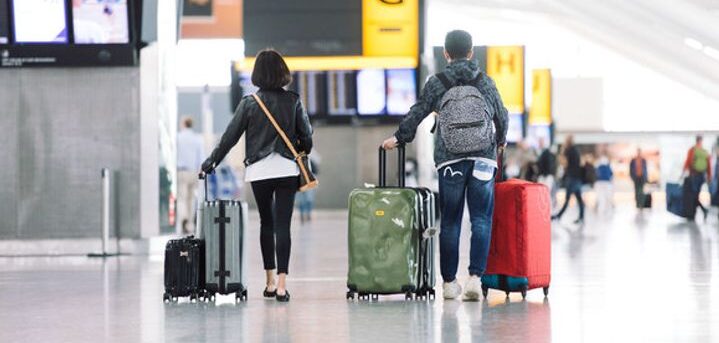In spite of a weaker-than-expected recovery in January, several European airports are maintaining a hopeful attitude toward the months ahead, with many predicting their busiest periods since the pandemic began.
For London Heathrow Airport (LHR), demand to travel in January was weaker than expected and over 56% down versus pre-pandemic levels as the aftermath of omicron continued to suppress passenger confidence. Over 1.3 million passengers canceled or failed to book their trips because of omicron restrictions in December and January. While bookings for LHR’s outbound tourism have been observed to be recovering, inbound tourism and business travel remain weak due to Covid-19 levels in the UK and other countries, international testing requirements and the risk of new border closures in the event of a new variant of concern.
John Holland-Kaye, CEO of Heathrow, said, “After a tough Christmas, omicron has continued to bite and this has been a weak start to the year. As short-lived as the additional travel restrictions were, they ruined the travel plans of more than 1.3 million passengers in the last two months.”
Passenger figures for January from Manchester Airports Group (MAG), which owns and operates Manchester, London Stansted and East Midlands airports, show how testing measures introduced in response to the omicron variant weakened demand for international travel. January passenger volumes were down 63.1% on the same month in 2019, which was significantly quieter than the recovery seen in autumn 2021. However, passenger numbers bounced back quickly in the days following the UK government’s announcement on January 24 and continue to build as school half-term holidays approach.
Avinor, the operator of Oslo Airport, Bergen Airport and a number of Norway’s other civil airports, received a total of 1,877,869 passengers in January 2022. This represented an increase of 123.1% compared with the same month in 2021 but also a 50.7% decrease from 2019.
The operator has maintained a positive outlook toward potential travel impediments primarily by focusing on the total 410,531 international passengers that traveled through Oslo Airport in 2021. Gaute Skallerud Riise, vice president of traffic development for Avinor, said, “We have seen an increase in passengers in January on international routes, especially from Oslo Airport. International traffic is now at almost the same volume as domestic routes from the capital’s airport. This is in spite of omicron, which is currently leaving its mark on society.
“We believe this increase may reflect high levels of vaccination, Covid-19 certificates, and a general increase in the desire to travel among the population despite the many travel restrictions that were in place during January. At the same time, the domestic market is also growing. Overall, we still remain some way below the traffic figures in 2019, which was our last normal year before the pandemic.”
Predictions
Looking forward, MAG is expecting to receive nearly 1.5 million passengers between February 11 and February 27, compared with only 73,000 over the same period in 2021, and anticipates that February half-term will one of its busiest periods since the pandemic began, as passengers respond to the removal of testing requirements and take advantage of a return to restriction-free travel.
The projected increase comes after the UK government’s announcement on January 24 that fully vaccinated passengers would no longer be required to take any tests when traveling to the UK from February 11. According to MAG, this announcement saw businesses across the travel industry record a sharp increase in bookings. The total airline seat capacity across MAG’s airports is around 20% higher for February and March than January.
LHR is also cautiously maintaining its forecast for the year at just over half of pre-pandemic levels on the basis that strong demand for outbound summer holidays could offset a weaker start to the year and is working with airlines and ground handlers to increase resources across the airport ahead of the summer peak.
Action
However, in light of the January slump, LHR has urged the UK government to support the recovery of travel by harmonizing international travel rules. Heathrow’s Holland-Kaye emphasized, “The removal of restrictions for vaccinated passengers in and out of the UK offers a ray of hope, but the omicron hangover proves demand remains fragile and at risk to new variants of concern and the government needs to set out a playbook for managing future variants that allows travel and trade to keep flowing.”
LHR also plans to continue working with the Civil Aviation Authority (CAA) on a better regulatory outcome for consumers by correcting the factual errors in its initial proposals and designing effective mechanisms to enable the fastest possible traffic recovery. In contrast, MAG is optimistically recruiting for hundreds of new roles across its three airports, to support operations and the passenger experience. MAG’s CEO, Charlie Cornish, said, “It’s great that passengers are clearly feeling more confident as we go into February half term, and we expect our airports to be busier than we have seen in recent months.
“We welcomed the government’s decision to reintroduce restriction-free travel in time for the holidays. Airlines are now putting on more seats and there’s a real sense of excitement for travel as we head into the summer season. Our strong recovery means we are looking to recruit all sorts of roles across our airports. With our terminals filling with passengers again, this is a fantastic time to consider a job in aviation.”

